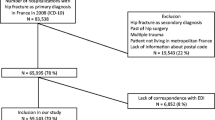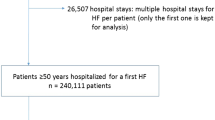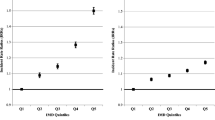Abstract
Summary
Age modifies the effect of area-level socioeconomic status (SES) in the risk of fragility hip fractures (HF). For older individuals, the risk of HF increases as SES increases. For younger individuals, risk of HF increases as SES decreases. Our study may help decision-makers to better direct the implementation of political decisions.
Introduction
The effect of socioeconomic status (SES) on hip fracture (HF) incidence remains unclear. The objective of this study is to evaluate the association between HF incidence and municipality-level SES as well as interactions between age and SES.
Methods
From the Portuguese Hospital Discharge Database, we selected hospitalizations (2000–2010) of patients aged 50+, with HF diagnosis (codes 820.x, ICD9-CM), caused by traumas of low/moderate energy, excluding bone cancer cases and readmissions for aftercare. Municipalities were classified according to SES (deprived to affluent) using 2001 Census data. A spatial Bayesian hierarchical regression model (controlling for data heterogeneity and spatial autocorrelation), using the Poisson distribution, was used to quantify the relative risk (RR) of HF, 95 % credible interval (95%CrI), and analyze the interaction between age and SES after adjusting for rural conditions.
Results
There were 96,905 HF, 77.3 % of which were on women who, on average, were older than men (mean age 81.2 ± 8.5 vs 78.2 ± 10.1 years) at admission (p < 0.001). In women, there was a lower risk associated with better SES: RR = 0.83 (95%CrI 0.65–1.00) for affluent versus deprived. There was an inverse association between SES and HF incidence rate in the youngest and a direct association in the oldest, for both sexes, but significant only between deprived and affluent in older ages (≥75 years).
Conclusions
Interaction between SES and age may be due to inequalities in lifestyles, access to health systems, and preventive actions. These results may help decision-makers to better understand the epidemiology of hip fractures and to better direct the available funding.



Similar content being viewed by others
References
Morrison A, Fan T, Sen SS, Weisenfluh L (2013) Epidemiology of falls and osteoporotic fractures: a systematic review. Clin Econ Outcomes Res: CEOR 5:9–18, Epub 2013/01/10
NIH Consensus Development Panel on Osteoporosis Prevention (2001) Diagnosis, and Therapy, March 7–29, 2000: highlights of the conference. South Med J 94(6):569–73, Epub 2001/07/07
Ivergård M, Svedbom A, Hernlund E, Compston J, Cooper C, Stenmark J et al (2013) Epidemiology and economic burden of osteoporosis in Portugal. A report prepared in collaboration with the International Osteoporosis Foundation (IOF) and the European Federation of Pharmaceutical Industry Associations (EFPIA). Arch Osteoporos 8:137(1–2):167
Bischoff HA, Stahelin HB, Dick W, Akos R, Knecht M, Salis C et al (2003) Effects of vitamin D and calcium supplementation on falls: a randomized controlled trial. J Bone Miner Res 18(2):343–51, Epub 2003/02/06
Kanis JA, Pitt FA (1992) Epidemiology of osteoporosis. Bone 13(Suppl 1):S7–15
Pina MF, Alves SM, Barbosa M, Barros H (2008) Hip fractures cluster in space: an epidemiological analysis in Portugal. Osteoporos Int 19:1797–804
West J, Hippisley-Cox J, Coupland CA, Price GM, Groom LM, Kendrick D et al (2004) Do rates of hospital admission for falls and hip fracture in elderly people vary by socio-economic status? Public Health 118(8):576–81, Epub 2004/11/09
Kanis JA, Borgstrom F, Compston J, Dreinhofer K, Nolte E, Jonsson L et al (2013) SCOPE: a scorecard for osteoporosis in Europe. Arch Osteoporos 8(1–2):144, Epub 2013/09/14
Benetos IS, Babis GC, Zoubos AB, Benetou V, Soucacos PN (2007) Factors affecting the risk of hip fractures. Injury 38(7):735–44, Epub 2007/02/20
Korpelainen R, Korpelainen J, Heikkinen J, Vaananen K, Keinanen-Kiukaanniemi S (2006) Lifelong risk factors f or osteoporosis and fractures in elderly women with low body mass index—a population-based study. Bone 39(2):385–91, Epub 2006/03/15
Farahmand BY, Persson PG, Michaelsson K, Baron JA, Parker MG, Ljunghall S et al (2000) Socioeconomic status, marital status and hip fracture risk: a population-based case–control study. Osteoporos Int 11(9):803–8, Epub 2001/01/10
Icks A, Haastert B, Wildner M, Becker C, Rapp K, Dragano N et al (2009) Hip fractures and area level socioeconomic conditions: a population-based study. BMC Public Health 9:114, Epub 2009/04/29
Suen LK (1998) Occupation and risk of hip fracture. J Public Health Med 20(4):428–33, Epub 1999/01/29
Jones S, Johansen A, Brennan J, Butler J, Lyons RA (2004) The effect of socioeconomic deprivation on fracture incidence in the United Kingdom. Osteoporos Int 15(7):520–4, Epub 2004/04/02
Peel NM, McClure RJ, Hendrikz JK (2007) Psychosocial factors associated with fall-related hip fractures. Age Ageing 36(2):145–51, Epub 2007/01/30
Brennan SL, Pasco JA, Urquhart DM, Oldenburg B, Hanna F, Wluka AE (2009) The association between socioeconomic status and osteoporotic fracture in population-based adults: a systematic review. Osteoporos Int 20(9):1487–97, Epub 2008/12/25
Vestergaard P, Rejnmark L, Mosekilde L (2006) Socioeconomic aspects of fractures within universal public healthcare: a nationwide case–control study from Denmark. Scand J Public Health 34(4):371–7, Epub 2006/07/25
Reimers A, Laflamme L (2007) Hip fractures among the elderly: personal and contextual social factors that matter. J Trauma 62(2):365–9, Epub 2007/02/14
INE Instituto Nacional de Estatística (2012). www.ine.pt. Accessed 13 Feb 2013
OECD (2011) Divided we stand: why inequality keeps rising. An overview of growing income inequalities in OECD countries: main findings. http://www.oecd.org/social/inequality.htm. Accessed 15 Apr 2013
Barros PP, Machado SR, Simoes J (2011) A Portugal. Health system review. Health Syst Transit 13(4):1–156, Epub 2012/01/10
ACSS (2011) Auditoria da codificação clínica [Clinical codification Audits]. http://portalcodgdh.min-saude.pt/index.php/Auditoria_da_codificação_cl%C3%ADnica. Accessed 12 June 2013
Moreira J. (2008) Fracturas Osteoporóticas do Colo do Fémur em Portugal e seus Determinantes Socioeconómicos. Porto: Faculdade de Engenharia da Universidade do Porto
Chevalley T, Herrmann FR, Delmi M, Stern R, Hoffmeyer P, Rapin CH et al (2002) Evaluation of the age-adjusted incidence of hip fractures between urban and rural areas: the difference is not related to the prevalence of institutions for the elderly. Osteoporos Int: J Established Result Cooperation Between Eur Foundation Osteoporos National Osteoporosis Foundation of the USA 13(2):113–8, Epub 2002/03/22
Banerjee S, Carlin BP, Gelfand AE. (2004) Hierarchical modeling and analysis for spatial data. In: Hall/CRC Ca, editor
R Core Team (2012) R: a language and environment for statistical computing. R Foundation for Statistical Computing. Vienna, Austria
Spiegelhalter D, Thomas A, Best N, Lunn D. WinBUGS User Manual (Version 1.4). 2003 January 2003. Report No.
Kaastad TS, Meyer HE, Falch JA (1998) Incidence of hip fracture in Oslo, Norway: differences within the city. Bone 22(2):175–8, Epub 1998/02/26
Guilley E, Herrmann F, Rapin CH, Hoffmeyer P, Rizzoli R, Chevalley T (2011) Socioeconomic and living conditions are determinants of hip fracture incidence and age occurrence among community-dwelling elderly. Osteoporos Int 22(2):647–53, Epub 2010/05/19
Wilson RT, Chase GA, Chrischilles EA, Wallace RB (2006) Hip fracture risk among community-dwelling elderly people in the United States: a prospective study of physical, cognitive, and socioeconomic indicators. Am J Public Health 96(7):1210–8, Epub 2006/06/01
Del Rio Barquero L, Romera Baures M, Pavia Segura J, Setoain Quinquer J, Serra Majem L, Garces Ruiz P et al (1992) Bone mineral density in two different socio-economic population groups. Bone Miner 18(2):159–68, Epub 1992/08/01
Varenna M, Binelli L, Zucchi F, Ghiringhelli D, Gallazzi M, Sinigaglia L (1999) Prevalence of osteoporosis by educational level in a cohort of postmenopausal women. Osteoporos Int 9(3):236–41, Epub 1999/08/18
Rapiti E, Fioretta G, Schaffar R, Neyroud-Caspar I, Verkooijen HM, Schmidlin F et al (2009) Impact of socioeconomic status on prostate cancer diagnosis, treatment, and prognosis. Cancer 115(23):5556–65, Epub 2009/09/30
Neuner JM, Zhang X, Sparapani R, Laud PW, Nattinger AB (2007) Racial and socioeconomic disparities in bone density testing before and after hip fracture. J Gen Intern Med 22(9):1239–45, Epub 2007/06/28
Brennan SL, Henry MJ, Wluka AE, Nicholson GC, Kotowicz MA, Williams JW et al (2009) BMD in population-based adult women is associated with socioeconomic status. J Bone Miner Res 24(5):809–15, Epub 2008/12/31
Alves SM, Economou T, Oliveira C, Ribeiro AI, Neves N, Gomez-Barrena E, et al. (2012) Osteoporotic hip fractures: Bisphosphonates sales and observed turning point in trend. A population-based retrospective study. Bone. Epub 2013/01/01
Acknowledgments
This work was supported by FEDER funds through the Programa Operacional Factores de Competitividade (COMPETE) and by Portuguese funds through Fundação para a Ciência e a Tecnologia (FCT) within the framework of the project PTDC/SAU-EPI/113424/2009 grant. We also acknowledge the Central Administration of Health Services (ACSS) for the data from the National Hospital Discharge Register.
Conflicts of interest
None.
Funding
The funder Fundação para a Ciência e Tecnologia—FCT has no role in this paper.
Author information
Authors and Affiliations
Corresponding author
Rights and permissions
About this article
Cite this article
Oliveira, C.M., Economou, T., Bailey, T. et al. The interactions between municipal socioeconomic status and age on hip fracture risk. Osteoporos Int 26, 489–498 (2015). https://doi.org/10.1007/s00198-014-2869-0
Received:
Accepted:
Published:
Issue Date:
DOI: https://doi.org/10.1007/s00198-014-2869-0




